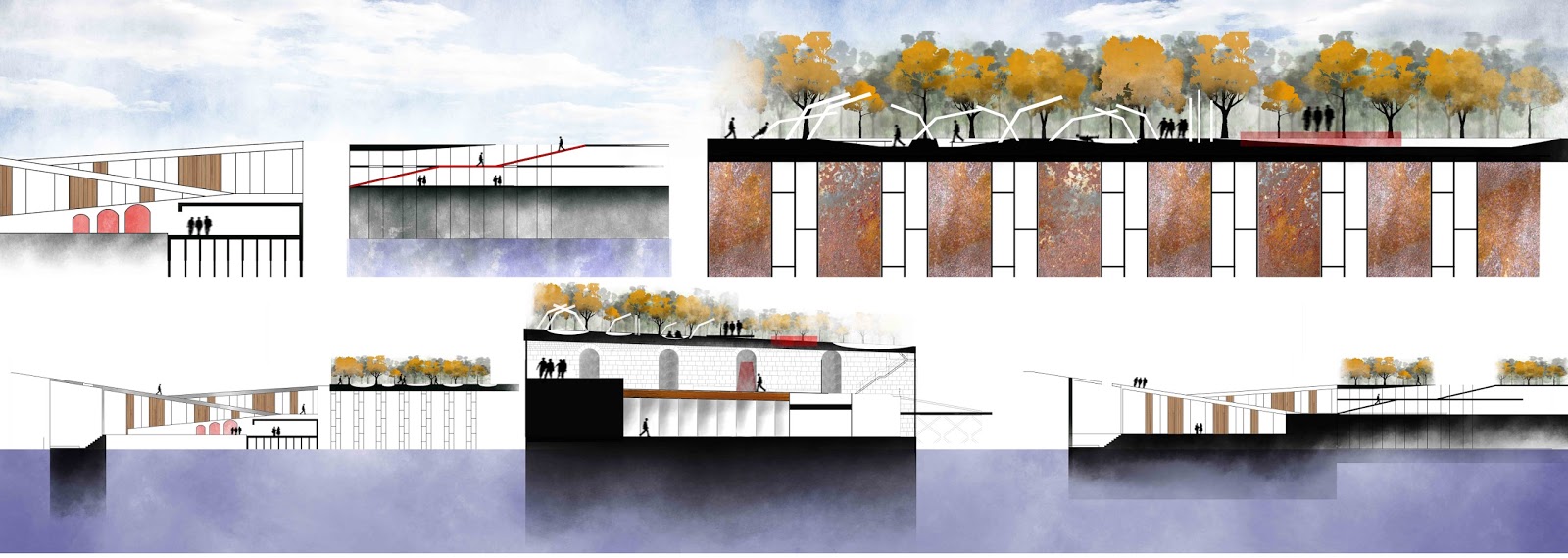Wednesday, September 18, 2013
Tuesday, June 4, 2013
Monday, April 15, 2013
FINAL DRAWINGS FOR PART A
MOMENTS, RHYTHMS AND VOLUMES.
Adolf Loos thought of Villa Muller as an
argument or statement for how people should live at the time. He bluntly rejected the accepted emerging
‘modernist’ theory which advocated open plan, and horizontality by imposing a
strict and austere or compressed articulation of spaces. He already had this
idea of a predetermined hierarchy and he just connected the dots with ‘stairs’.
Therefore, my initial concept for part ‘A’ is based around this tension between
modernist theories of the open plan and the freedom that it provides against
the directive and imposed circulation proposed by Loos. By looking at the level
1 circulation, I realized that there is an interesting ‘branching’ which takes place
at the most exciting moment within the living area. It is exciting because it
creates the network for the rest of the house and influences the ceiling
heights and rhythms of movement throughout the rest of the villa.
HIERARCHY
He suggests the herarcy then his job is to
connect it together. He just mainly focuses on the movement.
The materials
Inside and internal disengagement.
Refuge within refuge.
ORNAMENT AND CRIME.
Modernist motto FORM FOLLOWS FUNCTION.
He moved away from the idea of architecture
being accepted as a sector of art. He felt it was incredibly important to
distinguish art and architecture as having two separate purposes.
Part a
Branching point.
The point of decision like a branching
network. The central core of the house. An interesting contradiction to the
rest of the house which is controlled.
Part
and the whole. Completely disengaged with the outside world. Perhaps this was
inititated by the fact that there was a completely different architect who
designed the garden. My model aims to show a complete lack of engagement with
its surroundings.
5) He fails (in terms of because he
proposes a complete disengagement from the outside world, and proposes a modern
world which is disconnected from nature. Ironically he was correct in proposing
our dependence on the interior of architecture as finding a refuge in a place
of comfort.
Supply and demand regulate architectural form
economy and functionality.
Scale, geometry imposing a functional
program.
1) Beauty is in the functionality rather
than emotion, and instinct.
Emotion in architecture is dictated by our
ability to manipulate the outside to
3) The
visual distinction is not between complicated and simple, but between
"organic" and unnecessary decoration.
4) He is depicting a functional beauty
which he aims to set the standard for in the modern world. This is because
beauty is defined as in harmony and balance with nature, and his work seems out
of place.
Part B 1
PROSPECT AND REFUGE (public and private)
The perspective montages of the interior
views looking out the windows provide the audience with the feeling of refuge
and disengagement with the public landscape. By echoing the shortened
foreground, and exaggerating the sky I aim to create the feeling of incredibly
enclosed spaces and refuge within a room, which rejects its relationship to the
outside world.
-To explore the internal focus of the
‘wealthy’ interior and its disengagement with public surroundings.
Collages movement of materiality through
the space. Changing colours and textures comment on how the hierarchy of rooms
are organized.
Photographs
Part B 2
RHYTHMS AND MOMENTS
Movement and circulation is dicated by form
and geometry as they are strategically placed to create a series of thresholds.
Undulating levels and ceiling heights
impose a hierarchy > exploring what sort of life Loos is suggesting.
Subverting the idea of a closed and austere
representation allowing us to see and engage with the interior.
ABSTRACT MASSING MODEL: The mechanical
purpose of art/architecture. His building is a living experiment of how our
brains work in terms of organizing visual stimulus, in order to create
something that is organized and symmetrical rather. It is in this functional
organization that Loos’ notion of beauty comes through, and by employing this
mechanical cognition, which is innate within all designers, beauty exists in
functionality and predictable measures. How he turned to functionality and
visual cognition in order to establish a way of living. He moved architecture
away from emotion, and aesthetics and purely focused on a functional.
Subscribe to:
Posts (Atom)






































